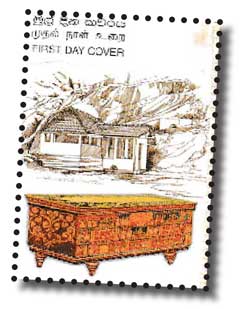Sunday Jan 18, 2026
Sunday Jan 18, 2026
Saturday, 6 May 2017 00:01 - - {{hitsCtrl.values.hits}}
 Sri Lankan Vesak stamps have become a fine vehicle to portray paintings in ancient temples. While the colourful murals in those temples can be admired through the stamps, they also pave the way for those interested to visit these temples, the locations of which, in many instances, are not well-known.
Sri Lankan Vesak stamps have become a fine vehicle to portray paintings in ancient temples. While the colourful murals in those temples can be admired through the stamps, they also pave the way for those interested to visit these temples, the locations of which, in many instances, are not well-known.
The murals also belong to various traditions depending on the time they had been drawn. Some in old temples have deteriorated while the quality of those belonging to the Kandyan period i.e. time when the king ruled from Kandy, remain quite good.
In addition to the murals on temple walls and often on the ceilings, the stamps have featured what seem to be rather unusual places to paint. A fine example is the intricate paintings done on a ‘pettagama’ – big wooden box found at the Nagolla Raja Maha Vihara, Kurunegala. The box features the Sambhava Jataka story in an area of 7ft 6½ins in length, 3ft 8ins in width and 2ft 111½ ins in height. 
The Jataka story is covered in five stamps released for Vesak 2004 using two First Day covers.
The stamps relate the story of King Dhananjaya Kaurawa’s quest for the formula to be a righteous ruler. Of the first set of four stamps, the first (top left hand Rs 4) depicts the king sending his Brahmin advisor Suchirata to meet the learned Pandit Vidura. The others show Suchirata meeting Vidura (Rs. 4.50), who in turn refers him to youthful Bhadraka (Rs. 16.50) followed by a meeting with another youth Sanjaya and then prince Sambhava who gives advice. Suchirata returns and hands over the gold leaf with the formula to the king (Rs. 20). The fifth stamp (Rs. 26) showing Suchirata meeting the youths Bhadraka and Sanjaya appears as an inset in a miniature sheet.
The story of the temple itself is a fascinating one. The temple is situated at the bottom of the Nagolla range of hills starting with the Kumbalpola protected forest in Kurunegala. A series of caves form the nucleus of the ancient temple. During excavations several things of historical value had been found. Among these had been a copy of the Tripitaka written on ola leaves. Other findings included Buddha staues and wall paintings. These are believed to have a long history dating back to the days of King Valagamba (89-77 BCE) when monks lived in forest hermitages devoting themselves to meditation. The temple has been in a perfect state even by 1782 as evidenced by writings on ola leaves.
There is also evidence to indicate that laymen had looked after the monks staying in separate caves. A cave library with rare texts recorded on ola leaves, caves where monks had lived, a vihara, a cave with paintings and Bodhi trees found at the premises are proof of the existence of a generation of the Sangha with adequate facilities.